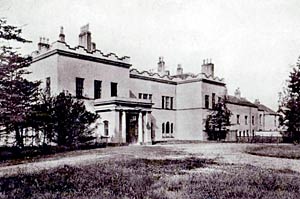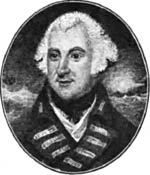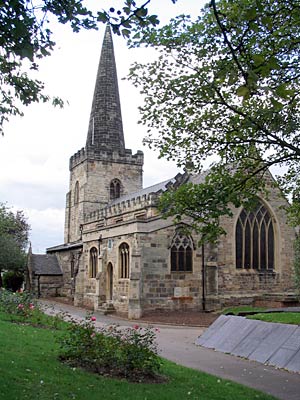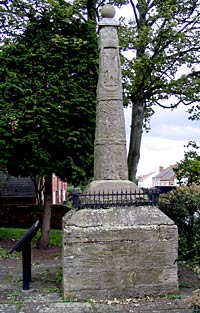< Previous | Contents | Next >
The Saxon Cross
STAPLEFORD. We come to it with amaze that half a century could bring about such change, for fifty years ago it was a quiet village. We leave it filled with wonder that in this world of change some things endure so long.

Stapleford Hall in the 1920s. It was demolished in 1935.
Stapleford has given away its rural charm and accepted its place in industry. The great house, rebuilt in 1797 by a sailor of Nelson's day, is no more, and the little river near where it stood no longer turns aside to give power to the old mill. The stocks and pinfold are no more, but the gabled manor house, rebuilt near them in 1689, is still standing proud and trim. The church has something left of 700 years ago; in its shadow is a priceless thing which has stood while half a hundred kings have ruled in England; and close to the village is what is said to be the most curious natural object in the county, older than man can tell.

Sir John Borlase Warren.
It is more than a century since Stapleford's great sailor died. He was John Borlase Warren, whose ruling passion as a boy was for the sea. He took part in the Colonial Wars, the troubles arising out of the French Revolution, and the fight against Napoleon. He was made a baronet and an admiral. One of his victories, for which he received the thanks of Parliament, was over the French fleet when it was carrying troops and supplies to the Irish rebels in 1798; he captured a ship of the line and three frigates.
A man of many parts was Sir John. He took his MA in 1776, and soon afterwards bought Lundy Island to accommodate his yacht and crew. In the intervals of naval service he lived at Stapleford Hall, representing the county town as MP. His last years were spent in the village, but he died when visiting Greenwich and was buried at Stretton Audley. He was greatly beloved for his courtesy and never-failing generosity. On re-entering the navy he bought out all the officers of the service who were imprisoned for debt in the Fleet and King's Bench prisons. The National School in the village is a monument to him for it was founded by his widow. In the church is a memorial to their only son who was killed at Aboukir.

Stapleford church in 2004.
Attractive outside, the church has a tower and spire from the three medieval centuries. The nave arcades are 14th century, the north a little older than the south. From about 1300 come the doorway letting us in (sheltered by an 18th century porch), some windows in the south aisle, and the east window of the chancel with its beautiful example of early tracery, formed by the simple intersection of the mullions. The font of this time has an unusual domed metal cover of about 1660. An oak carving of the Last Supper is foreign work, and was once the reredos. Two of the bells are believed to be 16th century.
For some generations the Teverys of Long Eaton were lords of Stapleford. Engraved on a floorstone are the portraits of Robert Tevery of 1571 in armour and his wife in Elizabethan dress. Gervase Tevery and his wife are lying on a massive monument; and kneeling on the floor are charming figures of three daughters and an only son, a tiny tot in a bonnet, all four battered through having been moved about since they were placed here 300 years ago.
A bright little chapel has been built in memory of about 200 men who did not come back from the war, its east window showing St Oswald, St George, and St Edward.

The Anglo-Saxon cross in 2004.
In our own time Stapleford's great treasure has been moved from its place in the street and set up in the churchyard. It is the famous cross, which has stood while England has seen the rise of all its royal dynasties. It was here when the Saxons worshipped in a little church of wattle and timber, and perhaps before there was a church at all. This tapering shaft of a Saxon cross, ten feet high and perhaps 1200 years old, is adorned with a mass of crude and worn interlacing work, and has on one side what is believed to be the symbol of St Luke, a horned figure with wings, treading on a serpent.
The cross is the oldest Christian memorial in the county, but older than anyone knows is the Hemlock Stone a mile away at Bramcote, standing proudly on a mound in a dip of the hills. A huge isolated mass of rock, with layers of harder stone protecting the softer sandstone below, it has resisted wind and weather through the ages.
From the high ground above the village we see the fires of Stanton's furnaces, which have so greatly developed in our time and now make pipes to carry water to teeming thousands in our towns.
In November 1936 a VC died here, a native of Grantham who joined the Navy in the second month of the war after working at Stanton ironworks. He was Walter Richard Parker, Lance-Corporal, who received the VC for bravery in Gallipoli, crossing a fire-swept zone at least 400 yards wide and attending the wounded in an isolated trench. The trench had finally to be evacuated, and Parker helped to remove the wounded, though he himself was seriously wounded during the operation.
